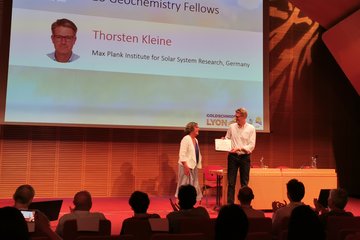Alle Typen
41.
Zeitschriftenartikel
First observations from the SPICE EUV spectrometer on Solar Orbiter. Astronomy and Astrophysics 656, A38 (2021)
42.
Zeitschriftenartikel
Cosmic-ray flux predictions and observations for and with Metis on board Solar Orbiter. Astronomy and Astrophysics 656, A15 (2021)
43.
Zeitschriftenartikel
Coronal Microjets in Quiet-Sun Regions Observed with the Extreme Ultraviolet Imager on Board the Solar Orbiter. Astrophysical Journal, Letters 918 (1), L20 (2021)
44.
Zeitschriftenartikel
Coronal Microjets in Quiet-Sun Regions Observed with the Extreme Ultraviolet Imager on Board the Solar Orbiter. The Astrophysical Journal 918, S. L20 (2021)
45.
Zeitschriftenartikel
Propagating brightenings in small loop-like structures in the quiet-Sun corona: Observations from Solar Orbiter/EUI. Astronomy and Astrophysics 656, L16 (2021)
46.
Zeitschriftenartikel
Multipoint remote and in situ observations of interplanetary coronal mass ejection structures during 2011 and associated geomagnetic storms. Monthly Notices of the Royal Astronomical Society 506 (1), S. 1186 - 1197 (2021)
47.
Zeitschriftenartikel
First light observations of the solar wind in the outer corona with the Metis coronagraph. Astronomy and Astrophysics 656, A32 (2021)
48.
Zeitschriftenartikel
Exploring the Solar Wind from Its Source on the Corona into the Inner Heliosphere during the First Solar Orbiter-Parker Solar Probe Quadrature. Astrophysical Journal, Letters 920 (1), L14 (2021)
49.
Zeitschriftenartikel
Stereoscopy of extreme UV quiet Sun brightenings observed by Solar Orbiter/EUI. Astronomy and Astrophysics 656, A35 (2021)
50.
Zeitschriftenartikel
The Solar Orbiter SPICE instrument: An extreme UV imaging spectrometer. Astronomy and Astrophysics 642, A14 (2020)
51.
Zeitschriftenartikel
Metis: the Solar Orbiter visible light and ultraviolet coronal imager. Astronomy and Astrophysics 642, A10 (2020)
52.
Zeitschriftenartikel
Coordination within the remote sensing payload on the Solar Orbiter mission. Astronomy and Astrophysics 642, A6 (2020)
53.
Zeitschriftenartikel
Optical design of the multi-wavelength imaging coronagraph Metis for the solar orbiter mission. Experimental Astronomy (2020)
54.
Zeitschriftenartikel
Probing the Thermodynamic State of a Coronal Mass Ejection (CME) Up to 1 AU. Frontiers in Astronomy and Space Sciences 7, 1 (2020)
55.
Zeitschriftenartikel
The Solar Orbiter EUI instrument: The Extreme Ultraviolet Imager. Astronomy and Astrophysics 642, A8 (2020)
56.
Zeitschriftenartikel
Models and data analysis tools for the Solar Orbiter mission. Astronomy and Astrophysics 642, A2 (2020)
57.
Zeitschriftenartikel
The Solar Orbiter Science Activity Plan: translating solar and heliospheric physics questions into action. Astronomy and Astrophysics 642, A3 (2020)
58.
Zeitschriftenartikel
Spectroscopy of Very Hot Plasma in Non-flaring Parts of a Solar Limb Active Region: Spatial and Temporal Properties. Astrophysical Journal 846 (1), 25 (2017)
59.
Zeitschriftenartikel
Propagating disturbances along fan-like coronal loops in an active region. Research in Astronomy and Astrophysics 15 (11), S. 1832 - 1842 (2015)
60.
Zeitschriftenartikel
Solar extreme ultraviolet variability of the quiet Sun. Astronomy and Astrophysics 581 (A51), A51 (2015)











